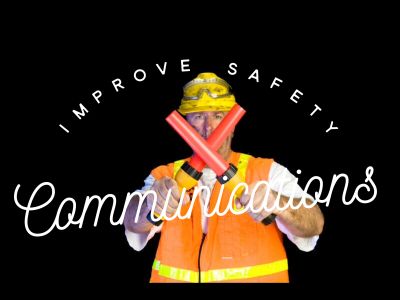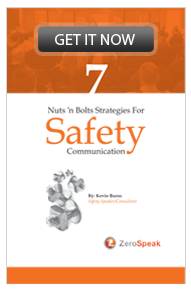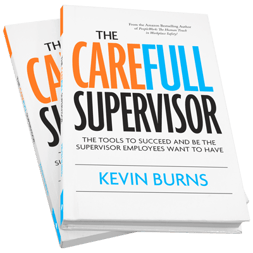To move people toward safety, you have to get the communications part right first.
 Safety performance is only as good as the quality of the communication. Communication matters. How you communicate can matter even more. It has been studied that 50-80% of a supervisor’s time is spent communicating. Since it is the biggest job supervisors and safety people do, you need to be good at it.
Safety performance is only as good as the quality of the communication. Communication matters. How you communicate can matter even more. It has been studied that 50-80% of a supervisor’s time is spent communicating. Since it is the biggest job supervisors and safety people do, you need to be good at it.
In safety, you will find warnings, communications and marketing. What’s the difference? Warnings warn. Communications inform. Marketing moves. For this article, we are going to focus on the communications part, especially how you communicate.
Here are four strategies that can immediately improve the level of your safety communications:
1Get rid of generic slogans. Safety First, Safety Now, and Be Safe are all generic, non-specific safety communications. But, too many use them as slogans and safety marketing campaigns. Then, they abandon them later when they see no discernible difference in safety performance. You can’t download a generic “safety” slogan off of the Internet and expect it to have mass appeal on your front line. Your people don't buy-in to them. So stop using them. They are undermining a real, heartfelt and personal message to your people. And stop the Dr. Seuss-like safety rhymes. Your head will go splat without your hard hat. That kind of communication undermines a solid safety plan that values and cares for its people. Cutesy slogans and generic phrases get in the way of you expressing a deep and compelling connection with your people.
2Ask your people why they dislike being reminded about safety. It’s communications, not a lecture. Communication means that information is exchanged two ways. One way communications are lectures and sermons. So ask what it is that your people dislike about the way they are communicated with. Solicit feedback. Maybe it’s that there is always a negative tone (gruesome photos and injuries-focused communications). Maybe it’s too many numbers and graphs. Maybe it’s that they feel you’re focused on rules and power. Ask. And then listen and don’t get defensive. You probably don’t even realize that the tone or choice of words are causing people to mentally check-out. But once you get the feedback on why they dislike being reminded about safety, you can create something that overcomes it. The best safety marketing, by the way, is based on addressing perceptions and misconceptions.
3Dump your reliance on PowerPoint to keep you organized. PowerPoint is making you stupid. PowerPoint is not meant to be a collection of your ideas. PowerPoint was designed to be a supplement to your ideas. And PowerPoint was never meant to be used as Corporate Karaoke; reading every word of your presentation off of a screen. You can’t be believable if you can’t talk about safety without your slide deck. People don’t engage with PowerPoint; they engage with other people. So connect with your people. Stop turning your back to the room to read your speech out loud from the screen. Instead, make a note of 3 points you want to talk about on a small piece of paper. Then talk about each point in detail. When you’ve finished talking about all three points, you’re done. Meeting over. If you forgot to mention something, it wasn’t important. If it was important, you can always go out into the field and address it one-on-one. Stop your PowerPoint dependency. Steve Jobs said, "People who know what they're talking about don't need PowerPoint."
4Zip it and spend more time listening. The Greek philosopher, Epictetus said, “We have two ears and one mouth so that we can listen twice as much as we speak.” The real secret to improving communication is listening. Most don’t know how to do that until you understand how we listen. Stephen Covey points out that we do not listen with the intent to understand; we listen with the intent to reply. While someone else is speaking, you’re formulating your response; the next clever thing to say. You’re not listening if you’re formulating a response. Instead, ask the questions. Engage your people. Ask them how safety could be made better. And listen to the answer. Your people will tell you everything you need to know if you ask the right questions and listen to the answers.
 Communication is important. Communications inform. And you have to be good at communications in order for your safety marketing message to be solid. Remember, at the beginning of this article we mentioned that marketing moves people. It does so in a positive way. To move people toward safety, you have to get the communications part right first. You can do all four strategies above easily. That is, if you truly want to be more effective.
Communication is important. Communications inform. And you have to be good at communications in order for your safety marketing message to be solid. Remember, at the beginning of this article we mentioned that marketing moves people. It does so in a positive way. To move people toward safety, you have to get the communications part right first. You can do all four strategies above easily. That is, if you truly want to be more effective.
Kevin Burns gives engaging, entertaining and inspiring presentations to front-line employees at safety meetings. He also works with supervisors and managers on-site or in keynote presentations at conferences. Kevin helps organizations integrate caring for and valuing employees through their safety programs. Kevin Burns is a management consultant, safety leadership speaker and author of 9 books. He is based in Calgary, Canada.
©2016 ZeroSpeak Corporation and Kevin Burns.
No part of this post may be reproduced without the expressed consent of the author.


